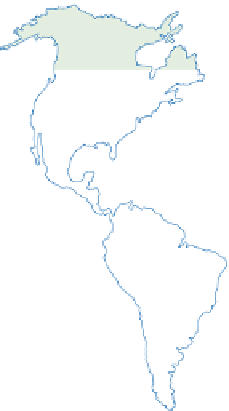Geoscience Reference
In-Depth Information
LONGITUDE
150
120
90
60
30
0
30
60
90
120
150
180
80
80
60
12
12
12
40
12
40
25
25
12
50
25
0
50
12
50
25
75
25
75
12
20
20
50
75
50
12
25
0
12
0
12
0
12
25
25
20
20
75
20
50
25
12
12
50
50
50
12
25
0
40
40
12
12
60
60
90
60
30
0
30
60
90
150
120
120
150
180
Source: After Budyko et al. (1962)
regions it is small, but it increases equatorwards, reaching
a maximum in the moist equatorial forests of South
America, central Africa and Indonesia. Over the desert
areas there is little moisture available and evaporation is
insignificant.
Release of energy
Where the state of water changes to a lower energy level
(i.e. from vapour to liquid or from liquid to solid) it will
release the same quantity of energy that was originally
used when it was raised to the higher energy state. This is
very important in our atmospheric heat balance. Water
that is evaporating from the surface will extract energy
from that surface, where there is usually a surplus anyway.
Eventually the vapour will condense in the atmosphere,
probably as a cloud droplet, releasing latent heat originally
extracted from the surface and so helping to warm
the atmosphere. This can take place well away from the
original evaporation point, so evaporation can transfer
heat energy both vertically and horizontally.
Much of Earth's surface is covered by oceans, where
evaporation takes place continuously. High values are
found over the warm water currents of the North Atlantic
and North Pacific Oceans. Even a large proportion of the
land surface is moist much of the time. Consequently the
role of latent heat in balancing the heat budget of Earth
is vital. Latent heat transfer by convection carries about
one-fifth of the energy of incoming solar radiation back
to the atmosphere (
Figure 3.11
).
The heat used for evaporation over land areas depends
upon the availability of moisture and energy. In polar
GLOBAL CIRCULATION
Four main forms of energy exist in atmospheric circula-
tion: latent heat, sensible heat, potential energy and kinetic
energy. The total energy of a unit mass of air (
E
t
) can
therefore be described as follows:
E
t
=
Lq
+
CpT
+
gz
+
V
2
/2
where
Lq
= latent heat content (latent heat of vaporization
specific humidity),
CpT
= sensible heat content (speci-
fic heat of air
temperature),
gz
= potential energy
(gravitational force
height) and
V
2
/2 = kinetic energy
(speed squared divided by two). Latent heat is the quantity
of heat released or absorbed, without any change of
temperature, during the transformation of a substance
from one state to another (e.g. from solid to liquid).
Sensible heat can be thought of as the temperature of the




























































































































































































































